The Land Of China -- Explore by Province
Shandong
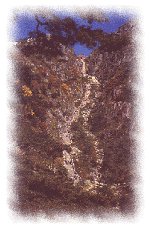 Shandong
Shandong
|
The province of Shandong is located in the east coast of China on the lower reaches of the Yellow River, separated from the Korean Peninsula by a stripe of water. Covering an area of 156,700 square kilometers, the province has a humid climate in the warm temperate zone with a population of 86,710,000.
The Yellow River breeds Chinese civilization and makes Shandong important in China's ancient history. The number of important relic protection units above the provincial level reaches 157. The Dawenkou Culture - a representative of the earliest culture of China - is prevalent here. Its famous tourist attractins include: the Three Kong in Qufu; the Three Meng in Zouxian County; Penglai Tower; Shuicheng; and the Lingyan Temple. Famous cultural relics include: Daminghu Lake; one of the four famous Buddhist temples in China, Yinque Mountain in Linyi; the Tomb Groups of the Han Dynasty in the Jinque Mountain; the Stone Tomb Groups of the Han Dynasty in Weifang; and the Shihu Garden and the Tomb of Suluwang in Dezhou.
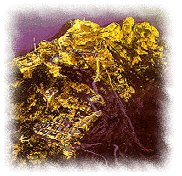 a View of Tai Shan
a View of Tai Shan
|
Besides these cultural relics, the province also boasts Tai Shan, the first of the five great mountains in China; Lao Shan, the Taoist sacred place standing beside the sea; Qianfo Mountain; and Spring City. The karst scenery in the north is no parallel to that in Zibo. The scenery of the banded lake group (with Taiwan Lake as the biggest) is attractive to many tourists as well. There are many good harbours and bathing beaches along the coastal line. Qingdao, Yantai, Penglai, and Weihai are all summer resorts. The famous historical and cultural cities in the province are Qufu, Jinan, Qingdao, Liaocheng and Zibo. The important national scenic spots are the Tai Mountain, the Lao Mountain, and the beaches in Jiaodong Peninsula.
Capital city, Jinan, is 15 kilometers south of the Yellow River and was the capital of a state in 6th century B.C. Today, it is called "the City of Springs" because of its over 100 springs. The springs are surrounded by lovely gardens and tea houses, and the quality of the spring water is excellent
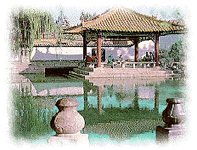 Baotu Spring Park
Baotu Spring Park
|
Baotu Spring is located in the Baotu Spring Park and is ranked first among the 72 famous springs in Jinan. The pool is square and surrounded with stone balustrades. Three columns of water spray out of the spring, and such a spectacle is one of the eight most famous scenes of Jinan. Emperor Qianiong's reign (1736-1795) of the Qing Dynasty gave it the title "First Spring Under Heaven."
The Quanfo Hill, or Thousand Buddha, is located 2.5 kilometers south of Jinan City. Between 581 and 600, numerous Buddhist statues were sculpted on the rocky cliffs. This large, mountainous park has many ancient pines, cypresses, and temples. Inside the Xinguo Monastery, which was first built in 627-649 during the Tang Dynasty, there are many Buddist statues that were carved in 587.
 Daming Lake
Daming Lake
|
The Daming Lake is located in the northern part of Jinan and covers an area of 86,000 square meters with 46,000 square meters of water surface. The lake is composed of the Zhenzhu (Pearl) Spring, the Furong (Lotus Flower) Spring, Wangfu (King's Mansion) Pool, and other sights. The Italian traveller Marco Polo described it as a beautiful garden. Famous historical relics located here include the Lixia Pavilion, Beiji Tower, Nanfeng Memorial, and Tiegong Memorial.
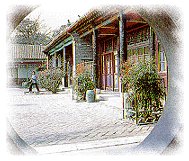 the Confucius Family Mansion
the Confucius Family Mansion
|
Located in Qufu, the Confucius (Kong) Family Mansion was first built 2,000 years ago and was expanded in the Ming and Qing dynasties (1368-1911). It was the residence and office of the first mate descendant of Confucius, with an area of 16,000 square meters and 463 rooms and halls. There are nine courts, each constructed one behind the other. The whole complex is composed of three parts: the Central, the Eastern, and the Western. In the front area of the Central part, there are offices shaped by three big halls and six smaller ones. The back area of the part contains living quarters and gardens. The family shrine is on the Eastern part. Study rooms and guestrooms are situated in the Western part where there is a large collection of rare treasures and ancient books.
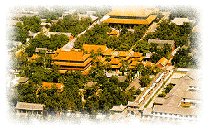 the Confucius Temple
the Confucius Temple
|
The Confucious Temple was first built in 478 B.C. Being approximately 22,000 square meters in size, it has nine courtyards with 466 rooms and halls laid out in a symmetrical fashion along a north-south axis that are well designed and richly ornamented. There are many trees and 28 stone columns, and a bas-relief of clouds and dragons is located in front of the Dacheng (Great Perfection) Hall, the main hall of the temple. The Xing Tan (Terrace of Apricots) is the place where Confucius used to give lectures to his disciples.
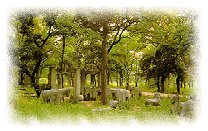 the Confucius Woods
the Confucius Woods
|
The Confucious Woods are located one kilometer north of Qufu City. The area of 200,000 square meters is surrounded by a three-meter-high brick wall that runs for 7 kilometers and also has more than 100,000 trees. It is also known as the Supreme Sage Woods. There are more than 100,000 graves of Kong descendants over a period of 2,000 years from the Zhou Dynasty. Because the Woods is such a well-kept family graveyard with such a long history, it is the most rare in the world.
 On Top of Tai at Sunset
On Top of Tai at Sunset
|
The majestic Mount Tai is one of many national parks in China and is the first of the Five Sacred Mountains in China. It covers an area of 426 square kilometers, and its main peak is 1,545 meters above sea level. In ancient China, many new emperors came here to perform grand sacrificial ceremonies in worship of the Heavens. Here, there are also many historical relics, such as the Wangmu Chi (Heavenly Queen Pool), Hongmen Gong (Red Gate Palace), Nan Tianmen (South Gate to Heaven), and the Bixia Ci (Azure Cloud Temple). There are also many stone carvings from various dynasties on a stone cliff in Jinshi Yu (Sutra Stone Valley), also called "The ancestor of big characters." In 1987 UNESCO listed Mount Tai as a World Natural and Cultural Heritage.
Qingdao (Green Island), the province's largest city, is on the Yellow Sea. It is well-known for its tasty Qingdao Beer and mineral water. The city is pretty with hills, trees, and red-tiled roofs and has 6 beaches which are usually crowded in the summer.
 the Pier at Qingdao Bay
the Pier at Qingdao Bay
|
The Pier is located in Qingdao Bay which is situated south of Qingdao City. It stretches into the sea from the shore. As the first wharf in Qingdao, built in 1891 an expanded in 1931, it is 440 meters long and eight meters wide. The north part of the pier is a stone base, while the southern part in the sea is made of steel and cement.
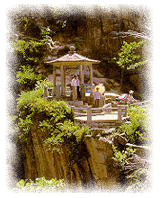 Lao Shan
Lao Shan
|
Its southern end is a semi-circle on which the Feige Huilan stands. The Feige Huilan (Bill Returning at the High Tower) is one of the ten most famous scenes of Qingdao.
Mount Lao is a national park that is located about 30 kilometers southeast of Qingdao with an area of more than 300 square kilometers. Standing on the north shore of the Yellow Sea, the majestic and beautiful mountain and sea unite together. Emperors of the Qin and Han dynasties 2,000 years ago would often come and visit Mount Lao. Temples were built here after the Song Dynasty (960-1279), and at one point there were more than 1,000 Taoist temples in existence. Today, only about a dozen of these Taoist temples have been well-preserved.
Yantai (Smoke Tower) is coastal city on the Bohai Sea. It is one of the prettiest small cities in China, nestled between the sea and gentle hills. Penglai Pavilion is said to be where the Eight Taoist Immortals flew across the sea. Here, mirages have been seen on the sea surface by many people. Yantai is a must for seafood lovers, for it produces prawns, abalone, scallops, jelly fish, and more. Also famous are its embroidery and wine. There are also two bathing beaches in the city proper.



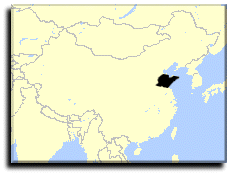














 Chinese Culture
Chinese Culture